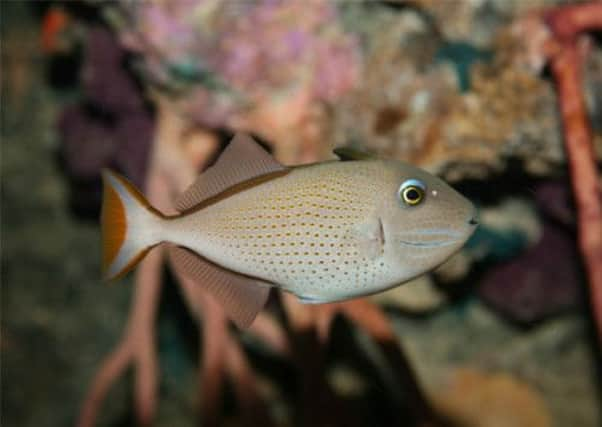Mull rare fish sighting a ‘sign of climate change’


The recording of a trigger fish near the west coast island has sparked fears the non-native species is spreading into northern coastal areas.
The sighting was thanks to new mobile apps which are aimed at combating invasive species in Scotland.
Advertisement
Hide AdAdvertisement
Hide AdScottish Natural Heritage is delighted the apps are allowing people to quickly and easily record non-native species across the country, which it claims is costing the Scottish economy £246million a year.
Stan Whitaker, SNH’s invasive non-native species expert, said many are a threat to native creatures and the local biodiversity, as well as being a help in discovering more about the effects of climate change.
He added: “The trigger fish are common in the Mediterranean, and breed in warmer climates. The average water temperature is showing an increasing trend year on year, which means we were naturally seeing southern species moving north.”
The sighting of a trigger fish near the Isle of Mull was recorded this Autumn.
Mr Whitaker said they have been spotted more and more in the south and southwest of England, and sporadically in Scotland, adding that their movement was a climate change indicator and scientists would like to better understand its distribution in UK waters.
He said: “You don’t have to be a diver or snorkeler to help us find out more about the invasive threats in Scotland’s waters.
“The apps feature many species that you’re just as likely to find in rock pools and on the shoreline. And if you own a boat, there’s every chance you may encounter species like sunfish while out at sea, or find the invasive species in marinas.”
The new apps include the AquaInvaders app which allows people across Scotland to report freshwater invasive species, and the Sealife Tracker which covers marine invasives, as well as a number of native species which indicate climate change.
Advertisement
Hide AdAdvertisement
Hide AdBoth apps are now available to download for both iPhone and Android.
With the apps, users are able to look at ID guides and information to identify and confirm a sighting, then upload a picture, add notes, and use GPS or a map to show their location.
The two apps join PlantTracker, which was the first app to allow the public to easily record what, where and when they see invasive non-native species in Scotland and throughout the UK.
About 15,000 people have downloaded the Plant Tracker app since it was launched in 2012, uncovering locations where invasive species were unknownbefore.
These apps are providing SNH and its partners with valuable, much-needed information about the location and spread of invasive and climate change indicator species.
The verified information will allow agencies to monitor and control and, in some cases, eradicate the spread of invasives.
Scot Mathieson, Principal Policy Officer for the Scottish Environment Protection Agency (SEPA), said: “The new apps are a great way to involve the general public in some of the work currently underway to conserve Scotland’s indigenous species from the spread of invasive, non-native wildlife.
“Hopefully it will encourage regular water users and enthusiasts alike to get involved in building a more comprehensive picture of the areas most at threat, and with swift reports from users on the ground, potentially allow us to respond to new outbreaks or potential pathways more effectively in the future.”
Advertisement
Hide AdAdvertisement
Hide AdThe AquaInvaders app targets the freshwater environment, where our rivers, burns, lochs and ponds are under increasing pressure from invasive non-native species, threatening the use and enjoyment of these areas.
It covers 12 species of fish, five species of crayfish, and four species of amphibians. The app is supported by the GB Non-Native Species Secretariat and the Rivers and Fisheries Trusts of Scotland.
The Sealife Tracker app features 25 species - 14 of which are climate change indicators and 11 that are invasive, non-native species.
Among the climate change species is the iconic sunfish and lesser known species such as wolf fish and northern stone crab. The invasive species being monitored include slipper limpet, wire weed and harpoon weed.
The project is a unique partnership between the British Sub Aqua Club, the Marine Biological Association, the Environment Agency, Scottish Natural Heritage, the Scottish Environment Protection Agency (SEPA), the University of Bristol and the Biological Records Centre.
The data collected by all projects is submitted to the Biological Records Centre (Centre for Ecology and Hydrology) where it is verified by experts and, in certain cases, responded to directly by the relevant authority. Once verified, data will be available publicly via the NBN (National Biodiversity Network) Gateway at https://data.nbn.org.uk/.